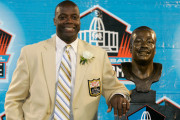All it takes is a split second. And that’s precisely what can be so agonizing for parents — not to mention the kids who get burned.
The small fire that had been used for cooking during a family get together in the great outdoors was out. But the coals were still hot. “I’ve been camping my whole life. I think all of us there always go camping, that was the normal thing,” says Chris Richter, who was a police officer and a volunteer firefighter at the time (he’s now an arson investigator and fire inspector at the Rosenberg Fire Department in Rosenberg, Texas). And they’d spent that time outdoors without incident. Until that day, when Richter’s 2-year-old son Grey was walking by the fire pit — and tripped, falling in hands-first onto the hot coals.
Richter’s sister and wife, Mandi, were outside with their kids, and his brother-in-law was sitting next to the fire pit when it happened. Richter was in a nearby cabin changing, getting ready to go with the family to an outdoor movie. Richter’s brother-in-law immediately grabbed Grey by the back of his shirt, picking him straight up, Richter says. Grey had ash and soot on his face. “Obviously, you could tell he was in pain. He was screaming [and] very upset,” Richter recalls, seeing him.
As it turned out, his face was OK, but Grey had sustained second and third degree burns on both of his palms and his right forearm. “His palms were already past that stage of blistering and peeling,” Richter recalls. After undergoing treatment at Shriners Hospitals for Children — Galveston, which included having skin grafts transplanted from the top of his head to his arm and hands, Grey, now 6, is doing well today. Although he still has scarring, the burn injuries he sustained don’t hold him back physically. “He’s extremely active,” Richter says, adding that’s probably helped him with rehabilitation which required him to stretch and move his hands.
However, when the dust settled immediately after the incident, Richter began doing what you might expect from a parent, let alone someone with firefighting experience: second-guessing. “Not even a day after, of course, me and Mandi hit that stage of: ‘We screwed up. We didn’t do something we were supposed to. It’s our first kid. How could we let this happen?'” Although he tries not to go too far down that road, he says dousing the fire immediately after they’d finished cooking is the No. 1 thing that could have been done differently.
[See: The 5 Latest Poison Control Threats Kids Face.]
Staying Vigilant
Burns are a leading cause of injury in children, and can be life-threatening. On average, every day, 300 kids ages 0 to 19 are treated in emergency rooms across the country for burn-related injuries “and two children die as a result of being burned,” according to the Centers for Disease Control and Prevention.
Toddlers, especially can quickly find trouble. “It’s usually the 1 1/2- to 3-year-old child that’s just getting curious, who likes to run up and grab, see what’s in everything, and they often pull hot stuff down on top of them; or they touch hot surfaces,” says Dr. Fred Mullins, medical director of the Joseph M. Still Burn Center at Doctors Hospital of Augusta in Georgia.
While outdoor fires and grills should be closely attended, kitchens tend to be ground zero for child burns. The majority of these burns are scald injuries, like when a child pulls down or spills something that’s piping hot onto themselves. “One of the biggest things is, in the kitchen, make sure it’s as safe as possible,” Mullins says. That includes turning pots so handles aren’t pointing out where little hands can grab them; and setting coffee cups and bowls of soup or other hot foods in the center of the counter, rather than at the edge.
Also, avoid dangling cords, says Linda Hollen, a pediatric surgery nurse practitioner at Dayton Children’s Hospital in Ohio. Experts in burn prevention say that goes from keeping cords for everything from clothing irons to hair straighteners to lamps to crockpots out of the reach of little ones. In a lot of kitchens, there will be an outlet on a kitchen island which is convenient, say, to plug in a crockpot. But then a young child motors by, pulls on the cord and down it comes, says Dr. Steven Wolf, chief of staff at Shriners Hospitals for Children — Galveston in Texas, editor of the journal Burns, and president of the American Burn Association.
To prevent burns, it’s also worth considering how your home is set up:
— “Water heaters in homes where children live need to be set at 120 or less,” Hollen says. Regulations today ensure that’s the case in most — but not all — homes, so check if you’re not sure.
— Don’t rely on glass-front fireplaces, or those with glass doors in homes with young children. These are a common source of contact burns, when children put their hands on the glass, Wolf says. Instead, put up a barrier that comes out from the fireplace, like a baby safety fence designed to be erected around a hearth.
— Move the microwave up to your level. Most microwaves are set where only adults can reach them, but some are lower, where kids not yet ready for the responsibility can get inside — which can lead to everything from scalding burns to fires that start in the unit. Even with older kids, it’s important that care is taken, as things like instant noodles can prove hazardous. “We see a lot of injuries in … early school age and younger kids from hot noodles,” Hollen says.
[See: 10 Things Pediatricians Advise That Parents Ignore — and Really Shouldn’t.]
Managing risk is something that parents not just of young children but older kids must do to prevent burns. Older kids or teens are developmentally inclined to take risks and boys especially may push the limits of safety; that can extend to doing something like, say, putting gas on a bonfire, Hollen says. She reiterates that parental supervision is important with older kids, too.
But sometimes parents or other adults encourage the risk-taking, and kids get burned as result. Another common source of contact burns in kids is motorcycle mufflers. “This happens mostly with teenagers,” Wolf says. “The inside of their right calf will come in contact with the muffler, and they’ll get a burn there.” He says that kids, including teens, shouldn’t ride on the back of motorcycles.
Nor should the garage be used as a play area, Hollen emphasizes. Young kids especially, who are too young to know they shouldn’t touch hot vehicles or equipment, can sustain muffler burns not just from coming into contact with a motorcycle but with a car or lawnmower.
Make sure your garage is well-ventilated, too, and watch where you put gas and paint cans. “If you have gas hot water heaters, a lot of times they’re in the garage, and if it’s not ventilated well, the fumes from the gas can [be ignited] by the pilot light for the hot water heater,” Mullins says. He adds that, frequently, the hot water heater is in a closet in the garage, and people will unknowingly put gas cans in the closet because they don’t want them sitting out. “If the garage catches on fire, the paint cans can act like bombs — they heat up and then explode.”
Make sure as well to have working carbon monoxide and smoke detectors in the home. “Test them monthly to make sure they work,” says Richter, who sees the aftermath of many fires in his work.
[See: The 11 Most Dangerous Places in Your Home for Babies and Small Kids.]
Freak accidents happen. But in general, experts say, child burns are preventable. “It’s the simple things that you don’t think about that will cause the burn,” Mullins says. “So it’s just being cognizant of your surroundings, and what’s around you and what’s around your children.”
More from U.S. News
Top Reasons Children End Up in the Hospital
10 (Mostly) Natural Ways to Evade Mosquitoes
13 Ways Social Determinants Affect Health
How to Prevent Child Burns originally appeared on usnews.com







